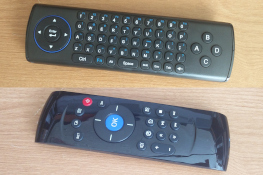Acer Aspire R3700 [borg]
This little black box is once again my main media PC strapped to the back of the living room TV (after the last round of PC / Raspberry Pi juggling).
Over the years, several other computers have filled this role: my Nano ITX PC (replaced due to the limited spec of the box - it just couldn't handle anything other than MPEG 2 / 4 videos. These days a lot of web video content is H264). Also One of my Raspberry Pi computers had this role.
I have this running Kodi via LibreELEC along with Music Player Daemon (MPD) in the background.
Kodi itself allows me to watch any videos that I have on the network, show photos, and more importantly get the likes of YouTube and Ted Talks on my telly since it is a pre-Internet telly. It can also play the same music that MPD does, but with visualisations!
Kodi has exclusive use of the HDMI for video and audio.
Since the storage requirements are next to zero for this, I have removed the SSD that was in it (now in one of the kids PCs) and simply run LibreELEC from an SD card.
I've also got a cracking wee keyboard / mouse gadget for it for those times when the TV remote control just won't cut it.
Kodi is set up to NFS mount all of the media from within the programme. However, to get all of the media from the server for MPD, I've mounted my NFS export directly into the filesystem. If you want to store music directly on the PC, then skip step 6a below.
It was extremely simple to set up...
- Plug an SDHC card into desktop PC (or laptop).
- Download and install LibreELEC to the card.
- Plug the SDHC card into the PC and power up, letting it re-size the SD card and then reboot.
- Install the Music Player Daemon: System -> Add-ons -> Install from repository -> LibreELEC Add-ons -> Services -> Music Player Daemon (MPD)
- Install as many add-ons as you like to Kodi. The SuperReop has literally thousands of them!
-
From the desktop PC, SSH into the PC and do the following:
- Set up a mount service to locate music on your network.
-
Edit the MPD configuration (note that there are actually two versions
in different locations for some reason, but this is the one you want):
nano ~/.kodi/userdata/addon_data/service.multimedia.mpd/config/mpd.confThe things that you'll want to change are the "music_directory" and an "audio_output" - I used the ALSA example to produce this:audio_output {
type "alsa"
name "S/PDIF -> Amp"
device "hw:2,0"
format "44100:16:2"
mixer_type "none"
} -
Since ALSA randomly assigns audio devices each boot, I had to
lock down the indices of them as by creating the file:
/etc/modprobe.d/alsa-base.conf
nano /etc/modprobe.d/alsa-base.confThen add the following# Ensure that the internal Intel audio is device 0
options snd-hda-intel index=0
# Ensure that the NVIDIA HDMI is device 1
options snd_hda_codec_hdmi index=1
# Ensure that the USB soundcard is device 2
options snd-usb-audio index=2 - Reboot the PC (to start MPD)
- Sit back and play / watch / listen!
Specifications:
| Unit: |
Acer Aspire R3700
(HDMI, VGA, Gigabyte Ethernet, 5 USB, S/PDIF, multi-card reader) |
| Processor: | Intel Atom D525 (1.8GHz) |
| RAM: | 4GByte DDR3, PC10600 (1333MHz), 9-9-9-24 timings |
| Graphics: | NVIDIA ION Chipset |
| Storage: | Sandisk Ultra, class 10 (32GByte micro SDHC) |
| Monitor: | Sony KDL-37W5500 (LCD TV) |
Helpful resources:










Computing Power
- Acer Aspire R3700
- Acknowledgements
- BOINC
- Desktop PC
- Eee PC 4G (701)
- Eee PC 901
- Gigabit Network
- Inspiron 14 5485 Laptop
- Kids PC 1
- Kids PC 2
- Media PC
- Mini-ITX PC
- My Useful Scripts
- Nano ITX PC
- Nook Simple Touch
- Processing Power
- Raspberry Pi
- Sharp Zaurus SL-C3200
- Storage Capacity
- The Server
- What Is Firmware
![My Media PC [borg]](images/Computers/borg/borg_profile_thumb.jpg)
![My Media PC [borg]](images/Computers/borg/borg_rear_thumb.jpg)




![Validate my Atom 1.0 feed [Valid Atom 1.0]](./images/valids/valid-atom10-yellow.gif)
![Validate my RSS 2.0 feed [Valid RSS 2.0]](./images/valids/valid-rss20-yellow.gif)